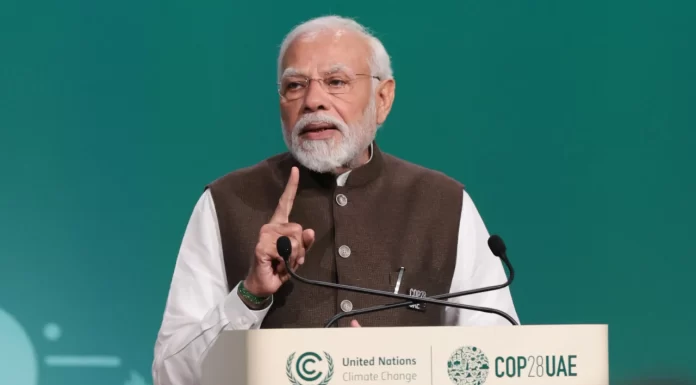The Green Credit Initiative, launched by Prime Minister Narendra Modi on the sidelines of COP 28, is part of the government's Lifestyle for Environment (LiFE) movement. In October 2023, the Government of India notified a policy for Green Credit, an innovative market-based mechanism to incentivise positive actions for environmental protection. This initiative promotes LiFE by encouraging community-based actions towards behavioural changes. The “Green Credit Rules” framed under the Environment Protection Act 1986 outline measures for individuals and entities to be eligible for the prescribed incentives.
The measures include tree plantation to increase green cover and address deforestation, efficient water management and conservation, promoting sustainable agricultural practices, effective waste management systems, reducing air pollution, conserving and restoring mangrove ecosystems, developing Ecomark labels to encourage manufacturers to obtain eco-friendly certifications, and promoting sustainable building and infrastructure. As per the rules, individuals, community groups, industries in both public and private sectors, and other stakeholders will be encouraged and incentivised to participate and promote various activities related to environmental protection and conservation.
The scheme envisages the generation of green credits by individuals and institutions, which will be tradable on a domestic platform, creating incentives through positive actions. The calculation of green credit will be linked to measurable environmental outcomes as decided and notified by the government. The scheme is implemented by the Ministry of Environment and Forests, with the Indian Council of Forestry Research and Education (ICFRE) in Dehradun designated as the ‘Administrator' of the scheme.
Despite its laudable and unique concept, the implementation of the scheme has been poor. Almost eight months after its announcement, there has been little progress. No guidelines defining ‘one green credit' under the various activities have been issued, and no technology platform for individuals and institutions to register for eligibility has been developed. A search on the website of the ‘Administrative Agency' reveals scant information about the scheme or its guidelines. The site only lists the names of officers in the “Green Credit Cell.” The nominated agency seems ill-prepared to promote the Green Credit scheme as a national movement.
Given the severity of environmental issues like global warming, natural calamities, floods, and droughts impacting large populations in India and worldwide, there is a pressing need to expedite the scheme's implementation and provide a sustainable framework involving the community and other stakeholders. The recent rise in temperatures in India is a cause for concern, necessitating a strategy and approach akin to mitigating a crisis. This scheme must be taken up as a movement, requiring a passionate and committed team exclusively focusing on it. Entrusting this responsibility to an existing institution may not provide the necessary resources, commitment, technology, and support for stakeholders, including farmers, NGOs, industries, and individuals, to engage in these activities on a long-term and sustainable basis.
In the words of Prime Minister, “Green credit is much more than carbon credit; it encompasses various aspects/issues of climate change.” India is the first country to start the green credit programme as its commitment to promoting activities for enforcing the Paris Agreement and COP 28 decisions on a comprehensive and sustainable basis. The methodology/guidelines issued in February 2024 encourage large-scale tree planting on open forests and scrub lands to generate credits under the scheme. These credits can be bought to meet obligations under Corporate Social Responsibility (CSR) and adherence to Environmental, Social, and Governance (ESG) norms. The government has identified about 20,000 hectares of land with the help of state governments and is promoting plantation on these lands through forest departments. Many large PSUs like NTPC, Oil India, Power Grid Corporation, and Coal India are paying for such plantations to government forest departments, making them eligible for green credit.
However, this process lacks community involvement, contradicting the scheme's original objective. Initially, the scheme announced that individuals planting 100 trees would be eligible for green credit. The focus has shifted from community/individual tree planting to large corporates in the public and private sectors funding forest departments. This shift cannot meet the desired objective of community involvement and national movement.
Similarly, waste and plastic circularity identified under the scheme can help make villages and towns plastic-free, but no guidelines have been formulated. ‘Waste to Wealth' can be formalised once green credit is extended as an incentive to those involved in waste collection, segregation, and processing. Water conservation, another area of concern, also lacks guidelines. Air pollution reduction and sustainable agriculture need special and immediate attention but are yet to be addressed under the scheme.
Despite the Prime Minister projecting Green Credit as a model for the world, the concerned agencies have not devoted adequate time and focus to its urgency. If it is to be taken as a movement, the entire implementing structure needs to be redesigned. An agency like Aadhaar (UIDAI), GSTN, or NHA (for Ayushman Bharat) should be established to expedite the Green Credit scheme's implementation. The present administrative structure does not inspire confidence for timely and successful implementation.
Green Credit will also generate employment opportunities, especially in rural India. For example, the circularity of waste and other resources in rural areas will promote a new breed of entrepreneurs as value-added services can be provided locally. Currently, waste collection, segregation, and processing are disaggregated and unorganised. With green credit incentives and eligibility norms, these activities can be organised into sustainable and meaningful enterprises. The Green Credit movement is not only about meeting our environmental commitments but also about creating new business avenues for the youth. It will also promote logistic activities and provide a framework for rural economic growth and development in India.
India's successful public digital infrastructure projects like UPI, Aadhaar, CoWIN, and DigiLocker are now examples for the world. Similarly, Green Credit, with a framework for stakeholder involvement, can be a guiding force for global adoption in addressing environmental concerns. Identifying activities, registering them, monitoring, and defining eligibility for green credit will require a comprehensive technology platform. Designing a trading platform for green credit will also need technology company involvement. Supervision and monitoring of identified projects should utilise advanced technology like satellite imaging rather than physical inspections.
One agenda for the new government should be to revisit the Green Credit scheme, establish an institution for speedy andfocused implementation, and create a unique technology platform for easy acceptance by all stakeholders. This should be designed and developed to become an example for the world in addressing environmental protection and conservation challenges. Time is of the essence in such initiatives, and the present institutional framework is not positioned to ensure timely and effective implementation.








